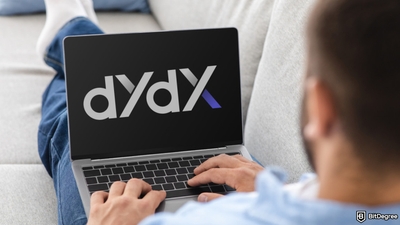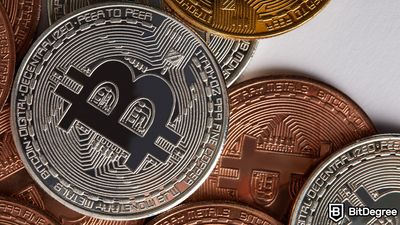Key Takeaways
- Monero is a decentralized, private, and fungible cryptocurrency that requires Monero miners to validate transactions;
- Monero mining used to be a profitable venture but rewards decreased once all coins were mined and tail emissions were introduced;
- If you're considering starting Monero mining, evaluate additional costs associated with the hash rate, electricity, hardware, etc.
Free Airdrop Season 7 is LIVE! Answer fun questions or do simple tasks to earn rewards from the $30K BitDegree prize pool. Participate Now ! 🔥
In the highly-competitive market of cryptocurrencies, Monero (XMR) has created a place for itself. Launched in April 2014, it is one of the top cryptocurrencies with a market capitalization of almost $3 billion.
Monero has become a favorite among many investors and miners because of its powerful performance throughout the years. For example, it managed to go up from $10 in January 2017 to $494 in January 2018, giving a return of around 4,800% to its investors. Isn’t that mind-blowing?
So, if you are thinking about Monero mining, then you’re not alone. The growth that Monero experienced throughout the years has brought a lot of attention to XMR mining.
However, Monero mining might seem a bit confusing, and you may have many questions such as: how does it work? What kind of software and hardware do I need? How do I start? How long does it take to mine one XMR? And so on, and so forth.
Don't worry, though, in this article I will answer all these questions (and many others related to Monero mining). So, by the end of this guide, you will have a clear understanding of what Monero mining is, and whether you should do it or not. On top of that, you'll also be able to find out about some of the best XMR mining platforms, too!
Before jumping to mining, though, it’s important for you to know that there is a much easier way to obtain Monero than by mining it. Simply pick a crypto exchange that supports Monero and have it in your wallet in no time. If you have no idea where to start, consider Bybit, Kraken, or Coinbase.
So, let’s get started!

Did you know?
Subscribe - We publish new crypto explainer videos every week!
What is Polygon in Crypto? (Animated Explainer)


Table of Contents
- 1. What is Monero (XMR)?
- 1.1. How is Monero Doing in 2024?
- 2. What is Monero Mining?
- 2.1. Types of Monero Mining
- 2.2. Monero Mining Rewards
- 2.3. Things to Consider Before Mining Monero
- 3. How to Mine Monero?
- 3.1. Mining Monero With a Central Processing Unit (CPU)
- 3.2. Mining Monero With a Graphics Processing Unit (GPU)
- 4. Should You Mine Monero?
- 5. Conclusions
What is Monero (XMR)?
Monero, just like Bitcoin, is a digital currency that can be used to send and receive payments. Imagine Carl wants to pay $100 to Ava, and they agree to do the transaction in cryptocurrency. Carl can make the payment using Bitcoin, Litecoin, Monero, or any other similar cryptocurrency.
Latest Deal Active Right Now:Head to BitDegree Missions, gather as many Bits as possible & claim your stake of the $30,000 Prize Pool! Don't waste your time & start collecting Bits by completing Missions and referring friends.
So, why would Carl use Monero?
Well, for one, if Carl and Ava want their transaction to remain untraceable and private, then Monero may be their best option. You see, it was created as a privacy-preserving asset.
Let me explain this further:
If Carl sends Ava some money using Bitcoin, the transaction is visible to everyone on the network. Everyone can see who the sender is and who the receiver is. This means that transactions sent in Bitcoin are public and out there for everyone to see.
Even though Bitcoin is decentralized, it is not private. Monero, however, is both decentralized and private. Monero’s technology allows all transactions to remain 100% private and untraceable.
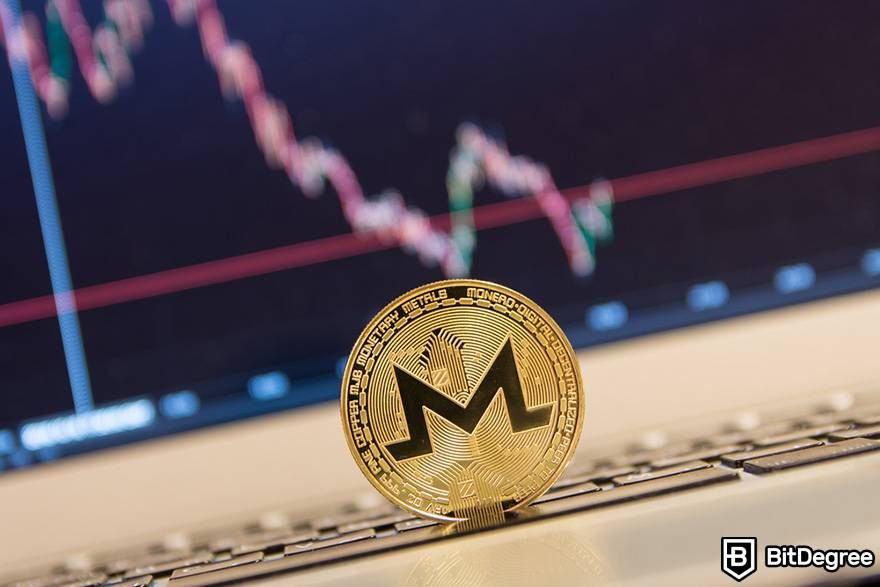
If the transaction is done using Monero, then Carl and Ava are the only two people who will know about this transaction. There is no one else on the Monero network that could find out that this transaction ever took place.
The privacy that is offered by Monero is what has made it so popular. As some people feel uncomfortable letting others know what they are spending their money on.
In addition to complete privacy, it's also important to note that Monero is fungible.
Sounds complex? Well, it isn’t. In fact, it’s a very simple concept.
Fungibility simply means that units of a currency are interchangeable. For example, a $100 bill can be replaced by another $100 bill, or even two $50 bills. This is what makes fiat currency (USD, EUR, JPY, etc.) fungible.
Bitcoin is not fungible (or, at least, not fungible to a certain extent). While it technically is fungible, someone might refuse to take a Bitcoin which has previously been used in illegal transactions. This is possible because everyone can see the transactions which have taken place on the Bitcoin network due to the lack of privacy it has.
So, one unit of Bitcoin might not be interchangeable with another Bitcoin, but this is not the case with Monero. Since no one knows anything about the previous transactions of a Monero coin, all of them are considered equal and are interchangeable with one another.
How is Monero Doing in 2024?
As of August 2024, there is a total of 18,267,333 XMR in circulation. It is also the total supply of Monero. Its price ranges at around $169, while its market cap is close to $3 billion (as was mentioned before). Besides, as of writing, Monero is in the 27th place of the biggest cryptocurrency list based on its market cap.
![]()
That being said, let's look into the process of Monero mining.
What is Monero Mining?
Monero mining is the process of validating transactions on the Monero network and creating new blocks. People who mine it are referred to as Monero miners. Overall, they perform two important tasks: confirm transactions and secure the Monero network.
Using the previous example, suppose Carl sends $100 to Ava via bank transfer. In this scenario, it is the bank’s job to make sure that Carl has enough balance to make the $100 payment to Ava. After the bank confirms this transaction, they make a record of it so that it can be referred to in the future. Now, if Carl were to send the $100 to Ava using Monero, who would validate and record this transaction?
That's right, the answer is Monero miners! They remove the need for banks to confirm transactions. But how exactly do they do that?
The Monero network is based on the Proof-of-Work consensus mechanism. So, Monero mining is PoW-based, just like Bitcoin mining. In essence, miners use high-powered software and hardware to solve difficult cryptographic equations. However, unlike the SHA-256 algorithm used by Bitcoin, Monero mining is done through the RandomX algorithm.
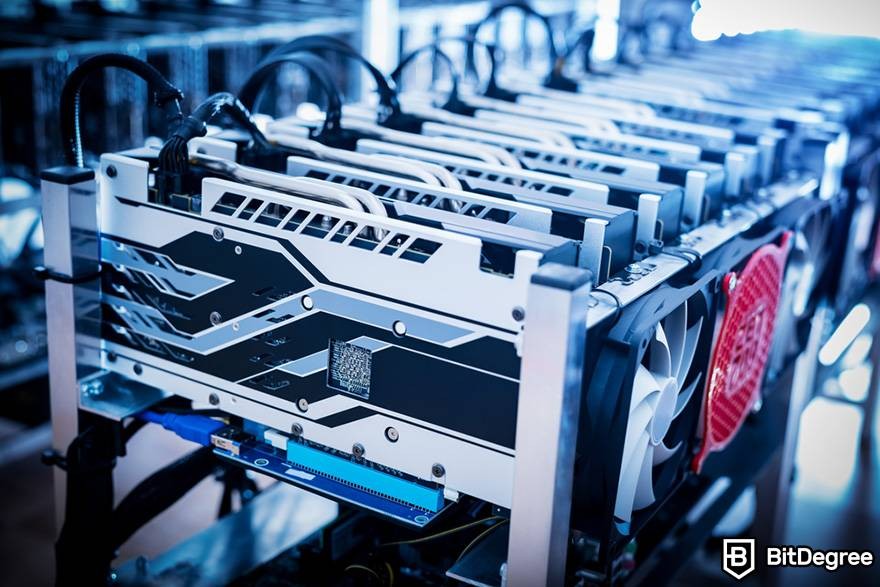
Thus, note that you don’t need to purchase special hardware for XMR mining. Anyone with a computer can mine Monero because it can be carried out using your computer’s CPU/GPU. This has made Monero a good option for beginners and other people who don’t want to invest lots of money to start mining.
With that said, keep in mind that the more powerful the hardware is, the better.
Now, a question that might come up next is what’s in it for the miners? Well, they get rewarded with newly mined XMR coins every time they use their resources to validate a group of transactions (called blocks)!
So, now that you know WHAT Monero mining is, you should also know that there are several ways you can mine Monero.
Types of Monero Mining
For starters, there are three main ways to mine Monero:
- Solo Mining
- Pool Mining
- P2Pool Mining
Solo mining, as the name suggests, refers to mining alone. In terms of securing the network, it is the best way to mine Monero because you directly interact with the Monero blockchain. However, solo mining is not recommended for beginners. Why?
For one, there is high competition. Besides that, solo mining will barely result in any rewards unless you are prepared to invest a lot of money into mining hardware, which is also costly to maintain. So, unless you already have a successful mining rig, solo mining is not the best option to choose.

Then, there is pool mining, which is a recommended way to mine Monero. In a mining pool, a group of Monero miners come together and combine the power of their hardware. This gives them a better chance of verifying transactions (yes, the competition is tough!).
The reward they receive from mining is also split between the mining pool. Most mining pools charge you a pool fee, which is generally in the range of 0-2%.
Imagine that you contribute 5% to the total hardware power of the mining pool you are in. This means that you will also receive 5% of the total rewards earned by the Monero mining pool.
You can choose from the many Monero mining pools in the market. Here is the list of the top Monero mining pools:
| Pool | Pool Fees | Number of Miners (as of August 23th, 2024) |
|---|---|---|
| xmr.nanopool.org | 1% | 2,148 |
| monero.hashvault.pro | 0.9% | 2,691 |
| SupportXMR.com | 0.6% | 5,596 |
| p2pool.io | 0% | 533 |
Table: Monero mining pools.
Now, you can also mine Monero using the P2Pool sidechain of Monero. It provides users with a P2P mining pool, which allows them to get rewards in the same frequency they would get by participating in Monero pool mining, just without the need of actually joining a centralized pool. Thus, miners are in full control of this pool.
In a way, P2Pool mining combines the benefits of both: single and pool mining.
So, we've settled the three main ways of mining Monero based on the process. However, you can also distinguish ways of mining Monero based on the hardware used:
- CPU Mining. It's a type of mining Monero using the Central Processing Unit (CPU) of your computer. To participate in CPU mining you need to have a computer and download a mining software program. CPU mining used to be a popular way to mine crypto. However, since the process of mining using a CPU is very slow, it's not that popular anymore.
- GPU Mining. It's a type of mining Monero using a Graphics Processing Unit (GPU). You can use one GPU or build a mining rig using several GPUs. For creating a mining rig, you must have a rig frame, a motherboard, and a processor. It's one of the more popular ways of mining Monero.
- ASIC Mining. It's a type of mining Monero using Application-Specific Integrated Circuits (ASIC) crypto mining devices. While using this method you can mine huge amounts of Monero, ASIC mining gets a lot of criticism due to the amount of electricity it uses and due to the fact that it "robs" GPU/CPU miners from the possibility of mining Monero.
- Cloud Mining. Now, this is a great option if you don't want to invest in any hardware. Cloud mining allows users to rent out a mining rig from a large mining facility. All you need to do is pay a fee for renting out that mining rig. The mining rewards are sent straight to your wallet. However, you do have to pay the fee in advance and you cannot change the software and hardware used.
Keep in mind that in the "how to" part I will be focusing on pool mining using CPU and GPU hardware because these are the most common ways of mining Monero. With that being said, you probably want to know how big Monero rewards are.
Monero Mining Rewards
In the past, when Monero mining was at its peak, a block reward was worth around 4.99 XMR. However, since the total supply of Monero has been reached, XMR tokens cannot be created at this rate. Though, the Monero network still needs miners to validate transactions, right?
Note: While the total supply of Monero is reached as of writing, there is no max supply set, which means that it could be increased in the future.
That's why in June 2022 Monero block rewards were reduced to a tail emission. So, the current reward for verifying (mining) 1 transaction block is around 0.6 XMR.
What are tail emissions exactly? They are tiny amounts of rewards paid in the coin in question that are used to encourage miners to continue validating transactions even after the total supply has been reached.

Now, another question you might be interested in is how long it takes to mine one Monero coin?
A Monero block is mined every 2 minutes. You already know that the current reward for mining a transaction block is 0.6 XMR. Doing the simple math, 1 XMR is mined every 3 minutes and 20 seconds.
If you're wondering whether you can still make money through Monero mining now, let me tell you this - it will not bring you millions in seconds. However, nobody knows what the price of Monero in the future will be. Besides, by mining Monero, you help to support its network, as well as the whole crypto ecosystem.
So, you know what is Monero mining, what types of Monero mining there are, and what are the rewards. Now, before jumping to the "how to" part, I also want to highlight some things you should think about before actually starting mining.
Things to Consider Before Mining Monero
The first thing you should consider is that, while Monero mining can be profitable, it depends on a lot of factors. The most important of them being:
- Hashrate: How powerful your hardware is.
- Power Consumption: How much electricity your hardware uses.
- Cost per KWh: How much your electricity costs per unit.
- Pool Fee: The fee for the mining pool you are joining (if you are participating in pool mining).
- The initial cost of setting up the hardware.
You can use a Monero mining profitability calculator online to help you weigh all these costs.
Besides, the profitability of mining also depends on the price of XMR. The prices of cryptocurrencies can increase and decrease very quickly.
Furthermore, another thing you should note is that, while you can mine Monero using ASIC, you will not have any advantage compared to other miners because Monero is ASIC-resistant. What this means is that, you will not be able to overshadow other miners with your high computational power.
FYI, an ASIC is a special type of hardware used for Bitcoin mining. An ASIC can cost anywhere between $600 to $1,000, which has made Bitcoin mining unattractive for anyone except professionals.
Fortunately, as you already know, Monero mining doesn’t require you to purchase an ASIC because it can be carried out using your computer’s CPU/GPU.
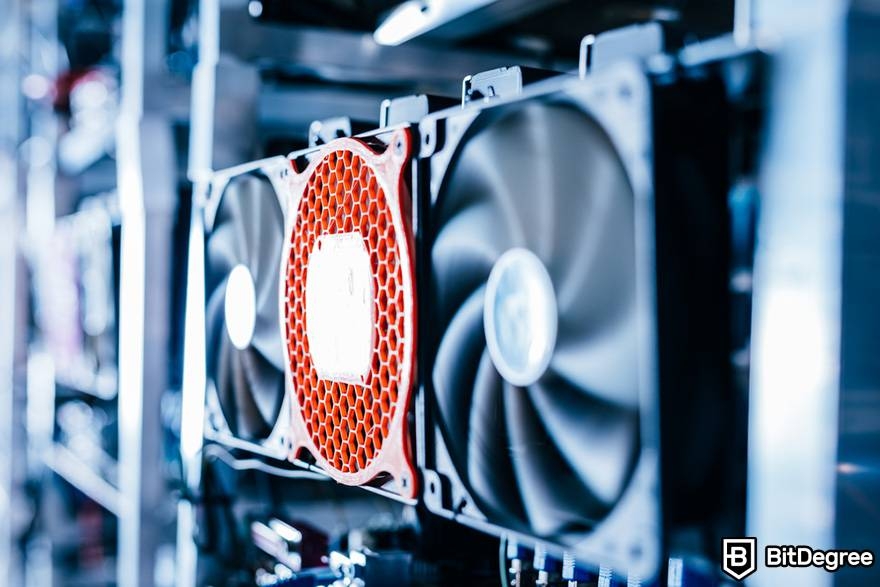
However, what you do need is a Monero Wallet for storing XMR. The first option you have is to choose from two wallets developed by the Monero community:
- Monero GUI Wallet. It is a free-to-use, open-source graphical user interface (GUI) wallet. This wallet is suitable for both novice and experienced users.
- Monero CLI Wallet. It is a free-to-use, open-source command line interface (CLI) wallet. This one is more suitable for experienced users, including developers.
Besides that, if you want to keep your funds really safe, you can also store Monero in hardware wallets (which is the recommended option[1]). Hardware wallets that support XMR coins include:
$70 BTC VOUCHER
Ledger Limited-time Deal
Unwrap your savings with this hot Ledger deal. Grab the Ledger Flex or Nano wallets and receive a $70 BTC Bonus. Secure both – your own funds and those of your loved ones!
Additionally, as indicated on the official Monero website, you can use such mobile wallets as Cake Wallet, Feather, and Monerujo, or light wallets such as MyMonero and Edge.
So, once you pick the wallet that is most suitable for you, you also have to choose what hardware you want to use and what type of pool you plan to join. I did provide you with several XMR mining pools above. As for the hardware, your best choices are either CPU- or GPU-based mining. So, let's talk about that.
How to Mine Monero?
You already know that the most important part of mining is to have the correct Monero mining hardware. Along with the hardware, you also need Monero mining software to help you connect with a Monero mining pool.
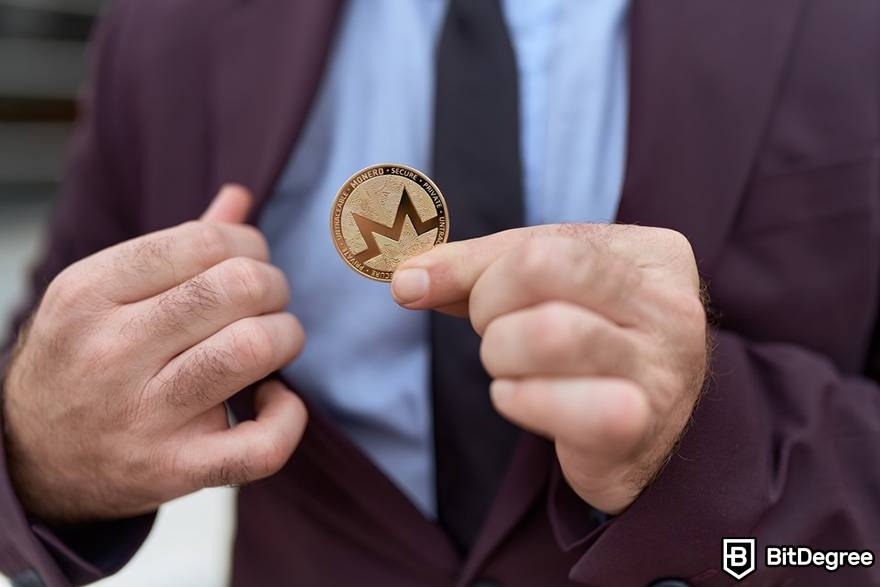
As I mentioned earlier, you don’t need specialized ASICs for mining Monero. It can be done using a CPU or a GPU. But before proceeding, you need to know the two most important factors when selecting your hardware.
You should look for:
- High hashrate - You can think of hash rate as the processing power of the hardware.
- Low electricity consumption - Electricity is the biggest cost of mining.
Now, let's proceed to the actual mining process.

Did you know?
Subscribe - We publish new crypto explainer videos every week!
How to Use Crypto? 5 Rewarding Strategies Explained (Animated)


Mining Monero With a Central Processing Unit (CPU)
Firstly, let's talk about mining Monero using a CPU. So, how to do it?
Step 1: You can use your current CPU or purchase a new one. If you are planning to buy a new CPU, then AMD Ryzen and Intel Core CPUs are the two that I would recommend.
| CPU | Cost | Hash Rate |
|---|---|---|
| AMD Ryzen 9 3900X | $350 | 4600 H/s |
| Intel Core i9-10900X | $515 | 4272.08 H/s |
Table: The comparison of AMD Ryzen 9 3900X and Intel Core i9-10900X cost and hash rate.
Step 2: Once you have your desired CPU, you will then need to download Monero mining software. You could consider using XMR-STAK-CPU as it is one of the most popular Monero miners — you can download it here. How to download it?
Click on the "Xmr-Stak-RX" box and scroll down until you see the "Assets" box.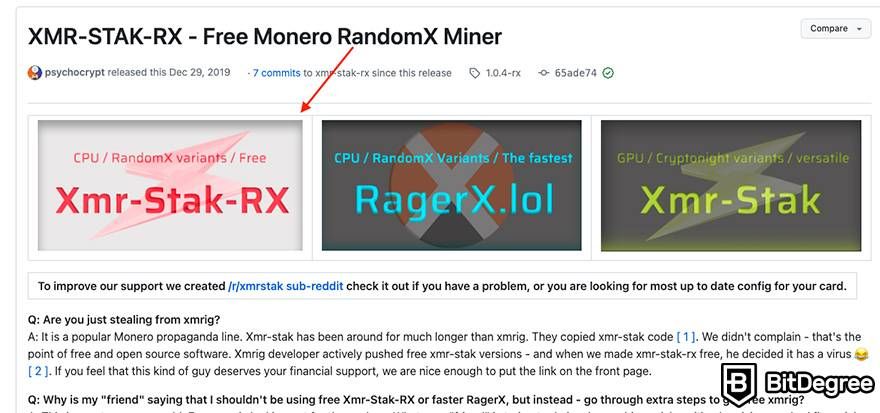
If you are using Windows, download "xmr-stak-rx-win64-1.0.4.zip". Unzip it and place it into your chosen directory.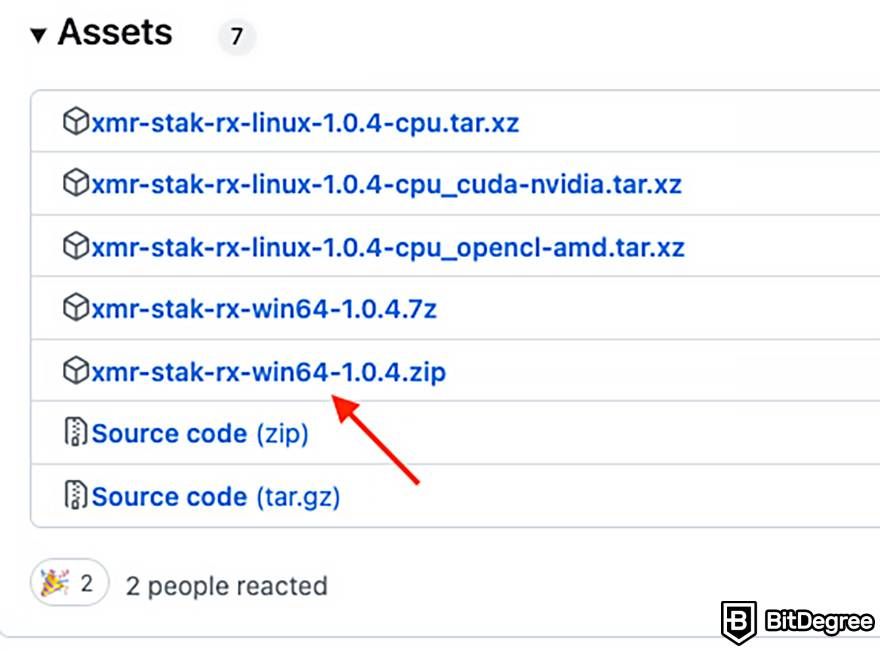
Then, also download the "Source code (zip)" file and follow the remaining steps of installation which you will find in the file. Just note that XMR Stak charges a development fee of 2%, unless you can compile the source code yourself.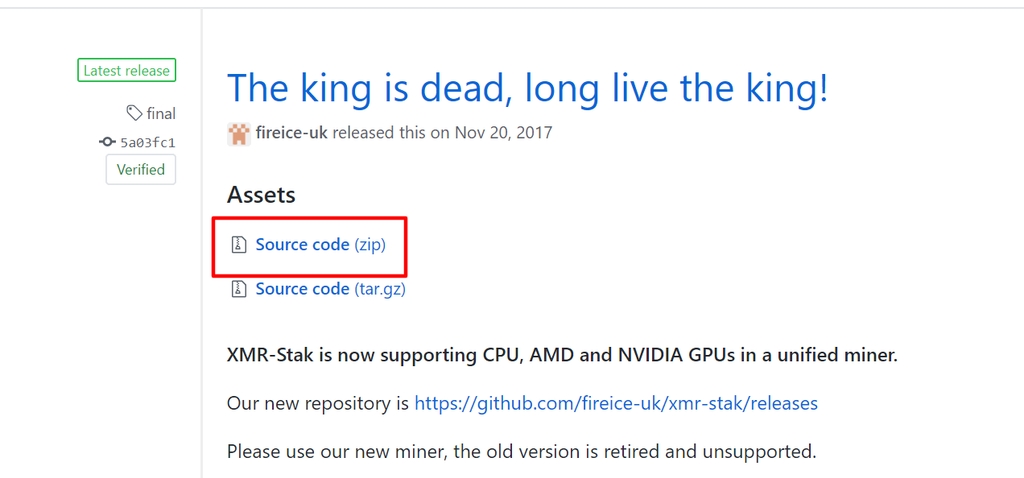
Step 4: After you set everything up, it's time to join a mining pool. You can choose from the ones mentioned above or check this site to find others. Do note that the bigger the pool, the less frequent payouts you get.
Step 5: Now, just configure your miner by typing in the address of the pool you chose, as well as your wallet address, and start mining!
That's it! That being said, let's move on to the GPU-based mining.

- Secure and reliable
- Accepts fiat currencies
- Lots of trading options
- Reputable exchange
- Accepts fiat currencies
- Offers various trading options

- Fiat currencies - accepted
- Simple to use
- Accepts only the most trustworthy cryptocurrencies
- A leading cryptocurrency exchange platform
- Best for beginner investors
- Accepts fiat currencies

- Fully reserved and transparent
- Multiple tradable asset classes
- Over 300 supported cryptos
- Over 300 cryptocurrencies
- Secure & transparent
- Fully reserved
Mining Monero With a Graphics Processing Unit (GPU)
If you are serious about Monero mining, then using a GPU is a better option. There are two GPUs that are most recommended for mining Monero – AMD and Nvidia. Let me walk you through the process of using both.
Mining Monero With an AMD GPU
Follow these steps if you want to mine Monero using an AMD GPU:
Step 1: Purchase an AMD graphics card. I suggest either AMD R9 280x or AMD Radeon Rx 580.
| GPU | Cost | Hash Rate |
|---|---|---|
| AMD R9 280x | $140 | 500 H/s |
| AMD Radeon Rx 580 | $300 - 400 | 575 H/s |
Table: The comparison of AMD R9 280x and AMD Radeon Rx 580 cost and hash rate.
Step 2: Install an AMD driver:
Go to the AMD support page and either use the "Auto-Detect" function or find the driver you want manually in the "Search for your product" field.
If you search manually, select your driver and press "Submit". You'll be taken to the page where you can choose the file to download based on your device's operating system.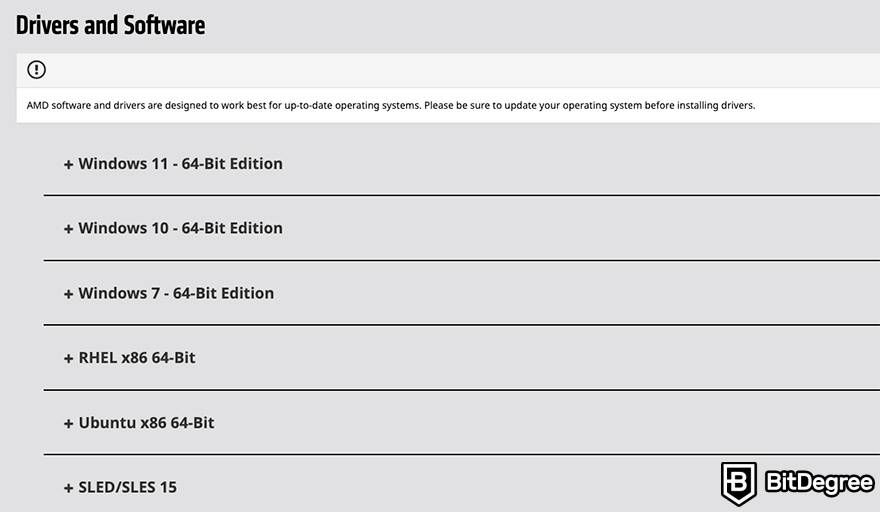
Then just download the .exe file you need, open the installer file, and follow the instructions that will pop up.
Step 3: Once you have installed the graphics card into your PC or laptop, follow the same steps as you would if you were CPU mining. The best Monero mining software when using AMD GPU hardware is XMR-STAK-AMD. It is a miner made specifically for AMD-based Monero mining. The installation process is similar to the one described above.
Step 4: Then, again, type in the address to the pool of your choice, as well as your wallet address, and start mining!
Now, let's talk about the Nvidia GPU.
Mining Monero With an Nvidia GPU
Using an Nvidia graphics card is another popular way to mine Monero. How to do that?
Step 1: Purchase an Nvidia graphics card. There are several models that you can choose from, it all depends on your budget. You should consider using one of the following:
| GPU | Cost | Hash Rate |
|---|---|---|
| Nvidia GTX 1070 | $400 - 500 | 505 H/s |
| Nvidia GTX 1080 | $550 - 650 | 600 H/s |
Table: The comparison of Nvidia GTX 1070 and Nvidia GTX 1080 cost and hash rate.
Step 2: Install an Nvidia driver:
You need to first download the Nvidia GeForce Experience.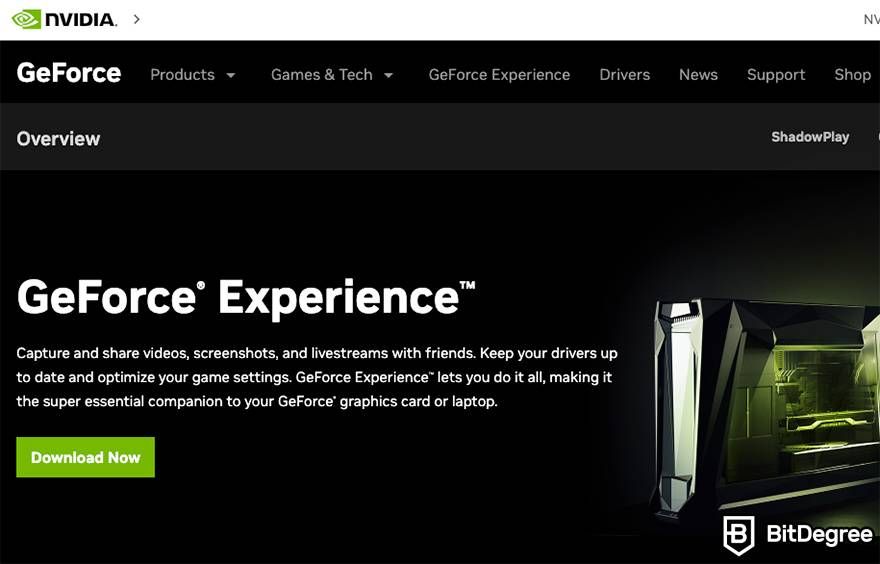
Once you've downloaded and opened it, select "check for updates" on the driver's tab in the main terminal.
The software will detect the hardware you have and provide you with the appropriate driver. You can then choose to go through "Express Installation" or "Custom Installation". I suggest picking the former.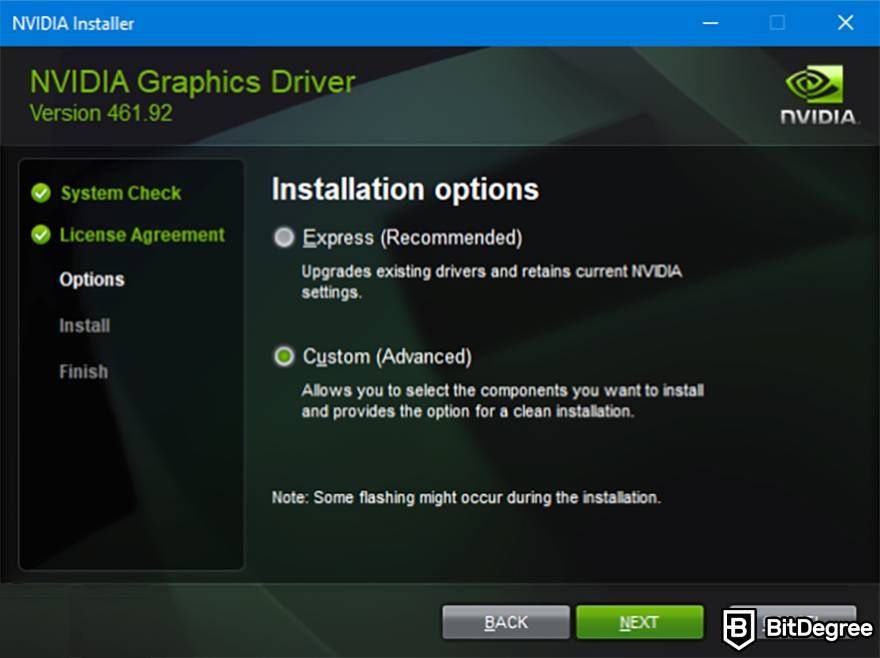
Step 3: As far as software is concerned, XMR-STAK-NVIDIA can also be used, but CCMiner is considered a better option. You can download the latest CCMiner release here. How to do it? The process is pretty similar to installing XMR-STAK software:
Make sure you choose the "ccminer-2.3.1-cuda10.7z", if you’re using a Windows operating system.
Then, also download the "Source code (zip)" file, unzip it, and follow the instructions until the installation process is complete.
Step 4: The last step is the same - choose a mining pool, configure your miner by typing in the mining pool address together with your wallet address, and start mining!
There you have it! These are some of the best methods for mining Monero using a combination of Monero mining hardware and Monero mining software.
Should You Mine Monero?
The answer to this question is completely up to you. However, to make it easier, I can tell you a few benefits and drawbacks of mining Monero.
In terms of the benefits, these are the main ones:
- By mining Monero, you contribute to the Monero network and the whole crypto ecosystem overall.
- Monero mining is ASIC-resistant, so it's a fair game for all miners.
- Monero mining can be done using your computer, so you don't need to buy tons of expensive mining equipment.
As for the drawbacks:
- Monero mining rewards have dropped due to the fact that the total XMR supply was reached.
- There are fewer crypto wallets that can store XMR tokens compared to, for example, Bitcoin.
What do you think, do the benefits outweigh the drawbacks? Also, make sure to evaluate your individual situation and make an informed decision. There are online calculators for miners to see whether crypto mining[2] is worth the effort!

|

|
|
|---|---|---|
| Beginners | Advanced Users & Beginners | |
| United States, Germany, United Kingdom, France, Canada, + 190 more | United States, United Kingdom, Germany, Canada, France, + 100 more | |
| All Kraken Coupons | All Coinbase Coupons | |
| One of the best crypto exchanges, especially in the US. | A reliable, well-known and respected cryptocurrency exchange platform. | |
|
Visit site
Read review |
Visit site
Read review |
Table: Coinbase and Kraken main feature comparison
Alternatively, you can invest in this cryptocurrency using Bybit, Coinbase, or Kraken. Make sure you check the transaction fees for each platform and invest wisely!
Conclusions
So, now you have a good understanding of what Monero is, and how is it different from Bitcoin. You also know what Monero mining is and the different ways to do it.
Monero mining may or may not be profitable, it all depends on these factors: hash rate, electricity cost, hardware cost, and so on.
If you feel like Monero mining is for you, then you can use the information in this guide to start mining!
If, however, you've decided that you'd like to take an alternative route of investing in cryptocurrencies, you could simply purchase some on platforms such as Binance, Bybit, Kraken, or Coinbase.
Also, once you buy or mine Monero, don't forget that you will need a secure cryptocurrency wallet. Consider hardware ones, such as Ledger Nano X!
If you decide to start your Monero mining journey, I wish you all the best!
The content published on this website is not aimed to give any kind of financial, investment, trading, or any other form of advice. BitDegree.org does not endorse or suggest you to buy, sell or hold any kind of cryptocurrency. Before making financial investment decisions, do consult your financial advisor.
Scientific References
1. A. G. Khan, A. H. Zahid, M. Hussain, et al: ‘Security Of Cryptocurrency Using Hardware Wallet And QR Code’;
2. J. Rüth, T. Zimmermann, K. Wolsing, et al: ‘Digging into Browser-based Crypto Mining’.






